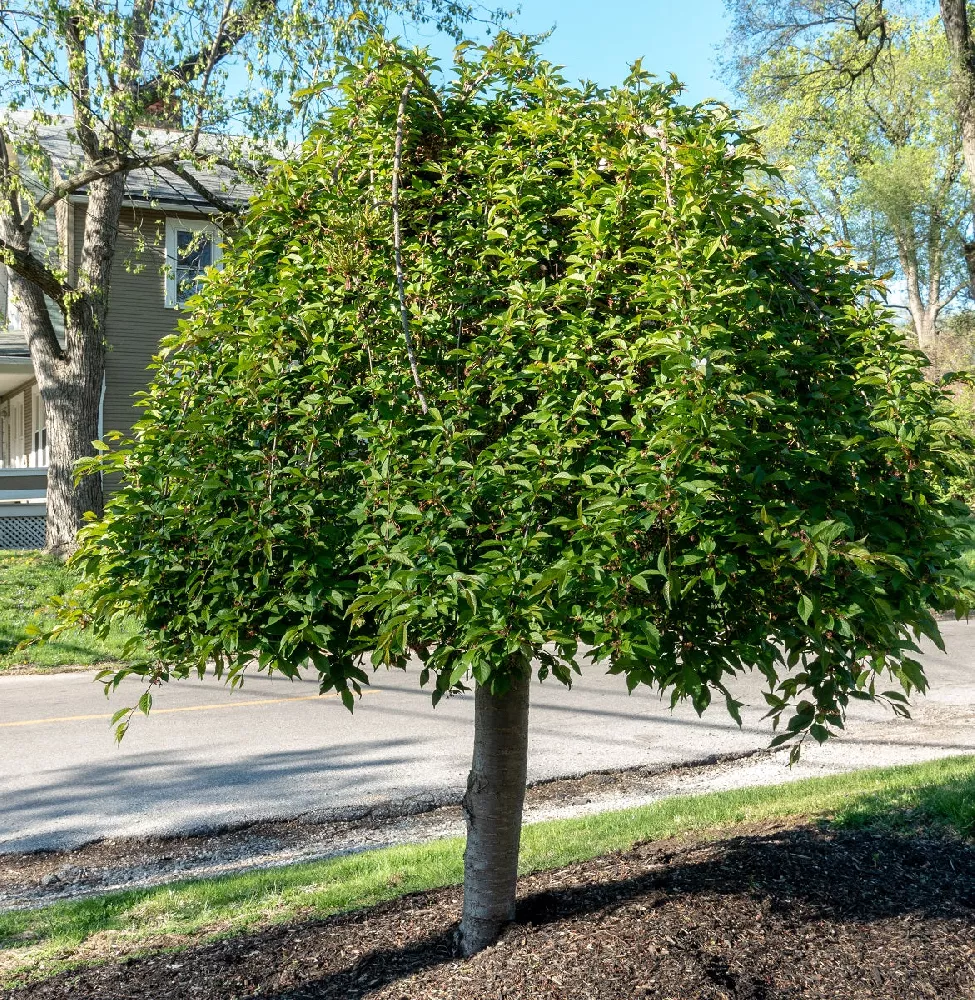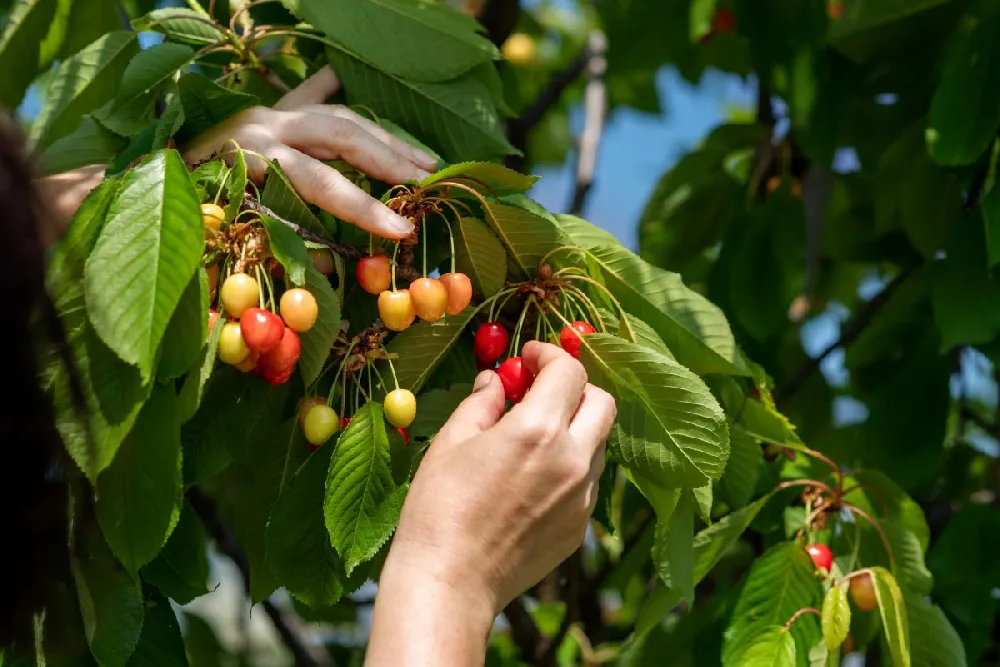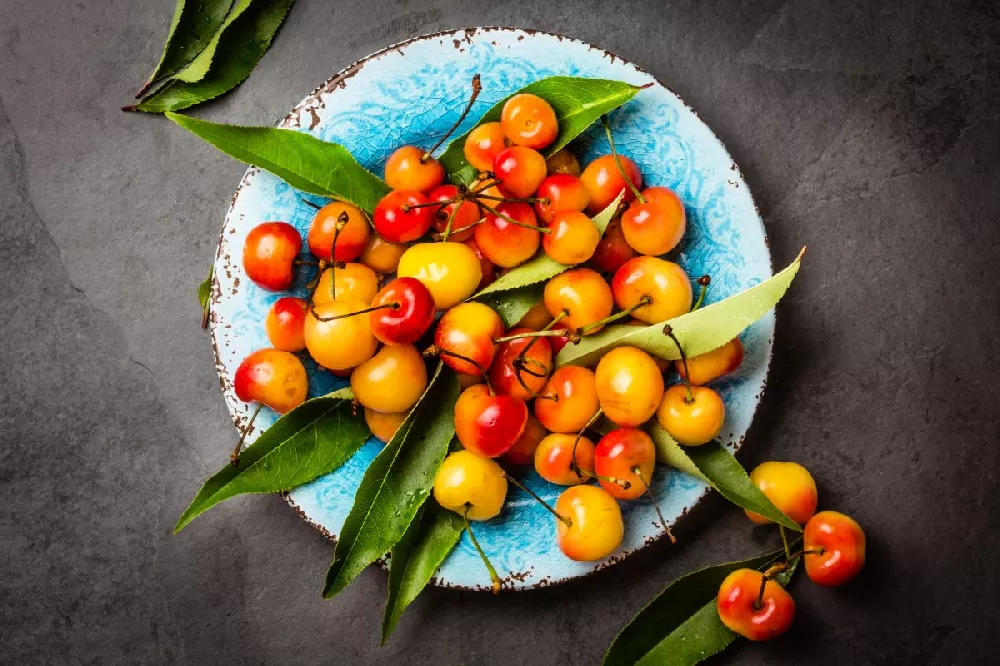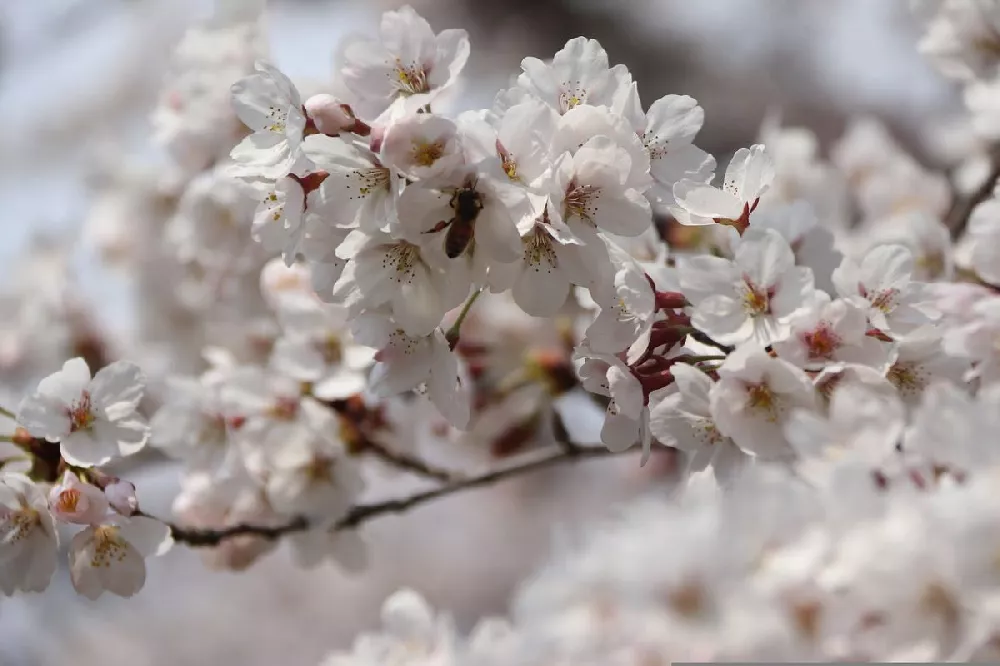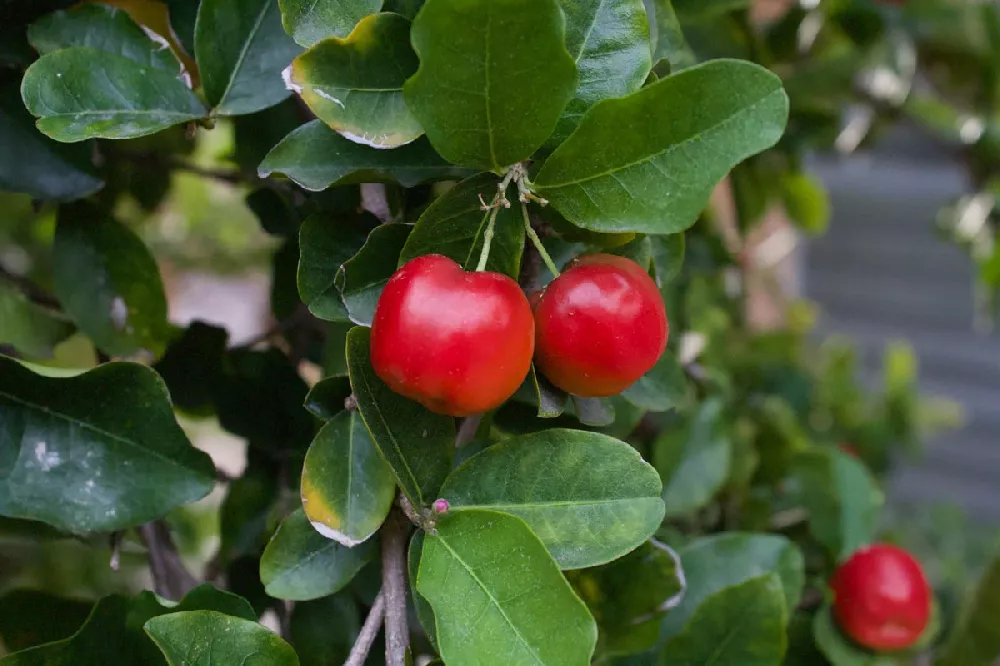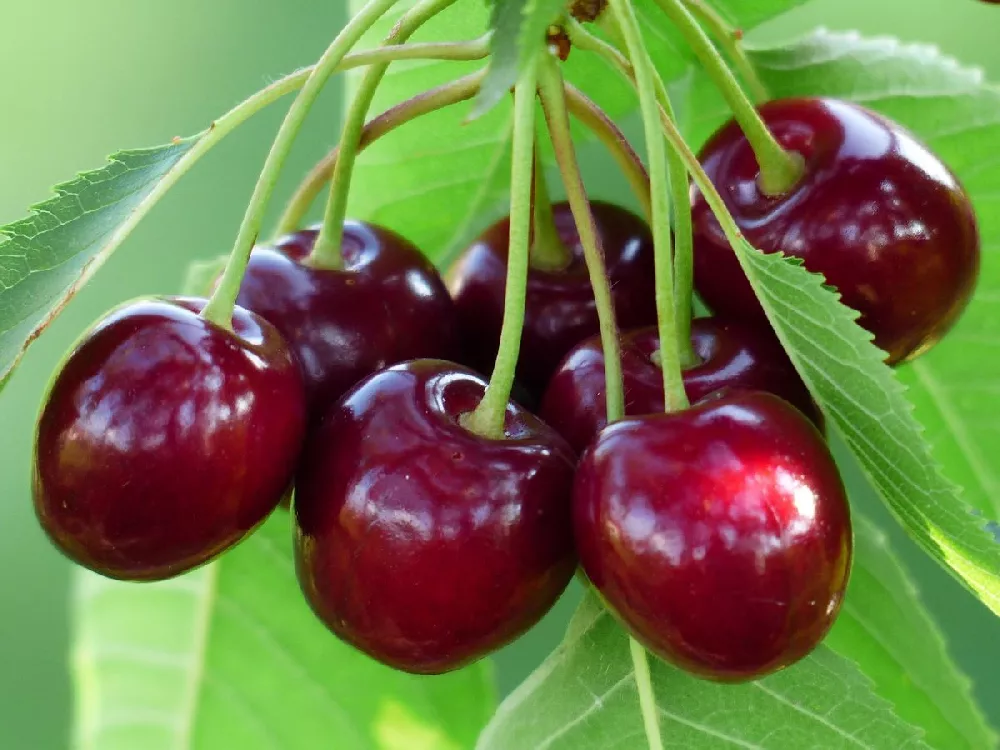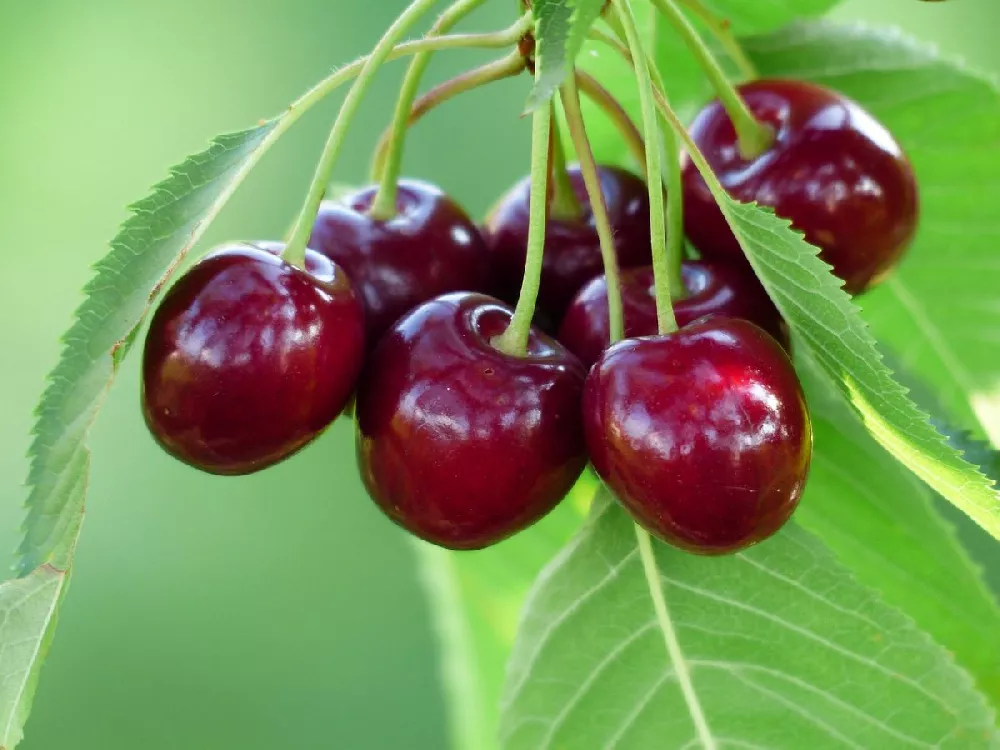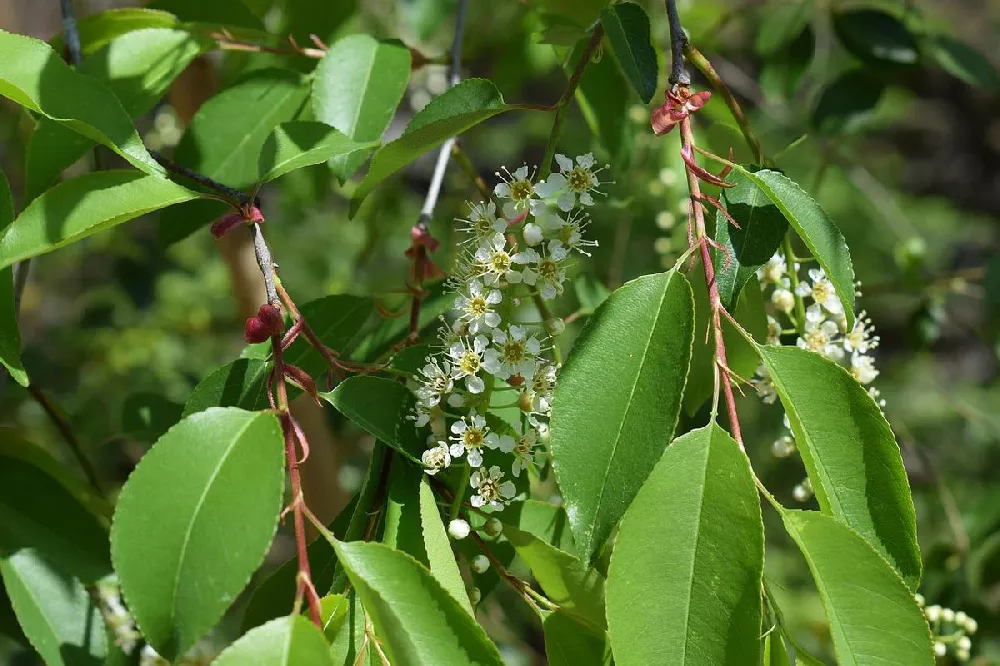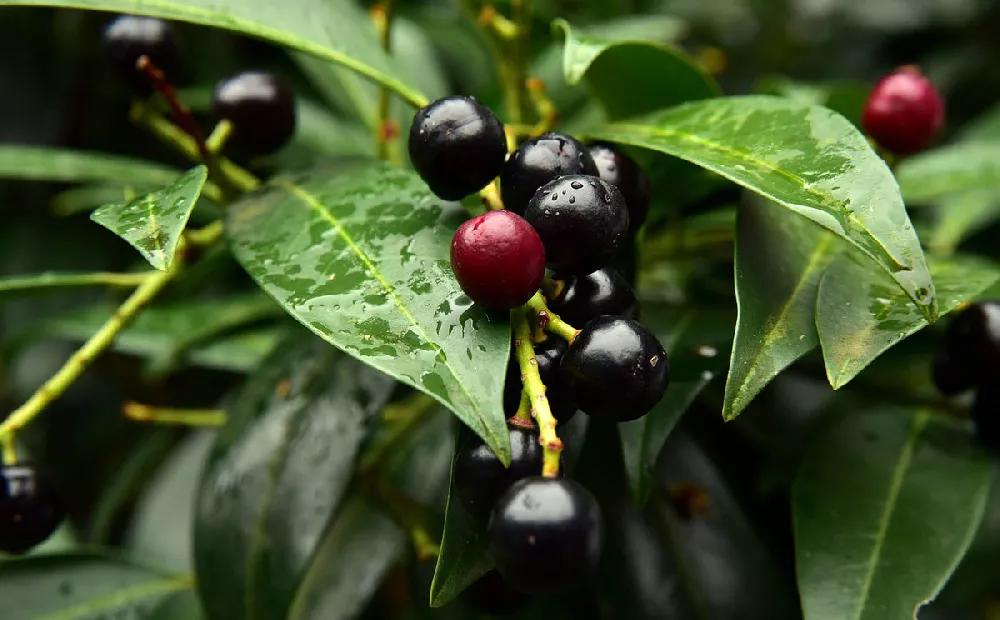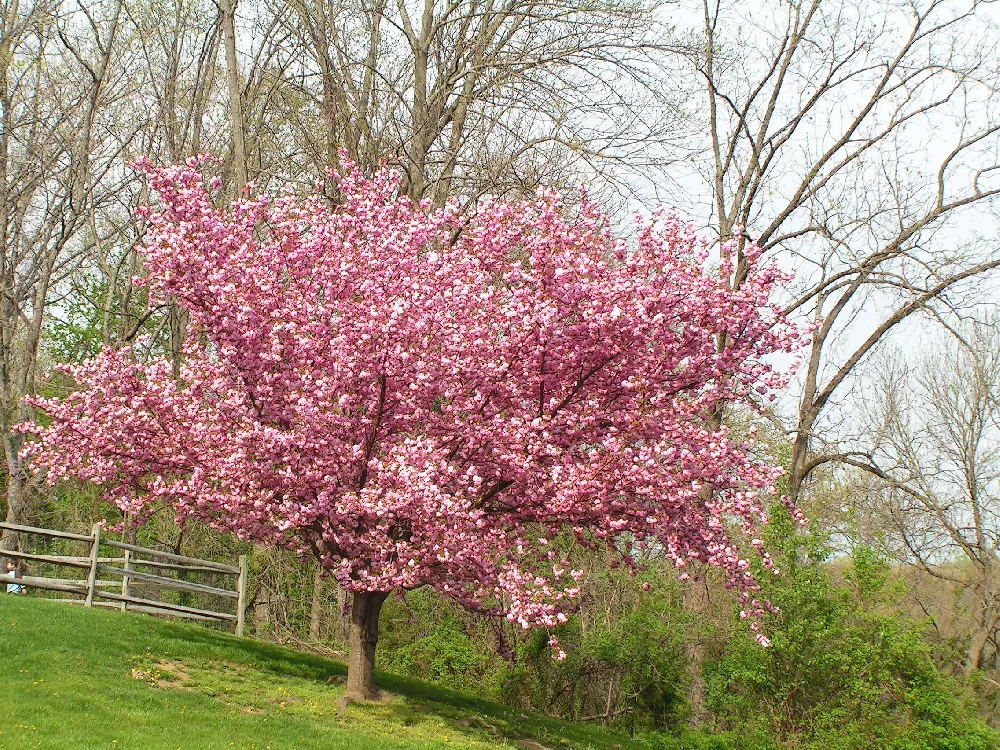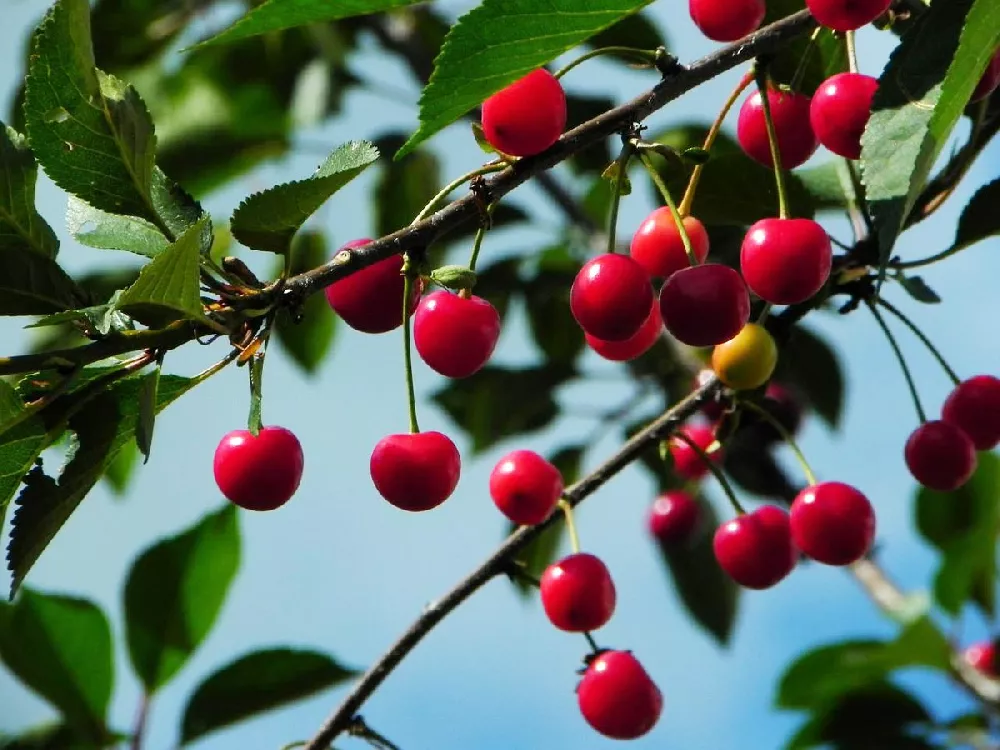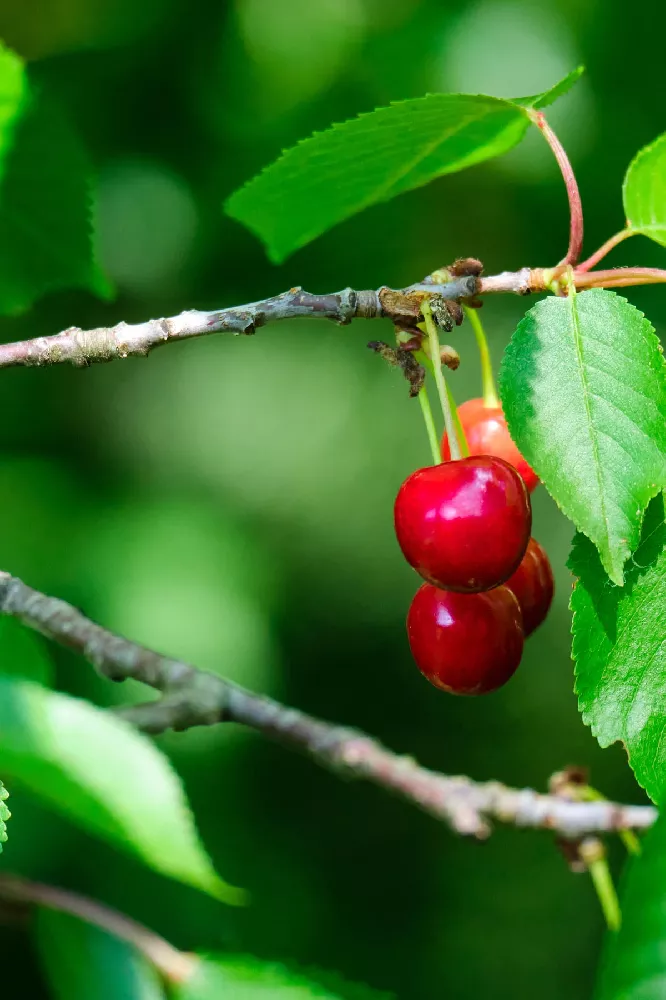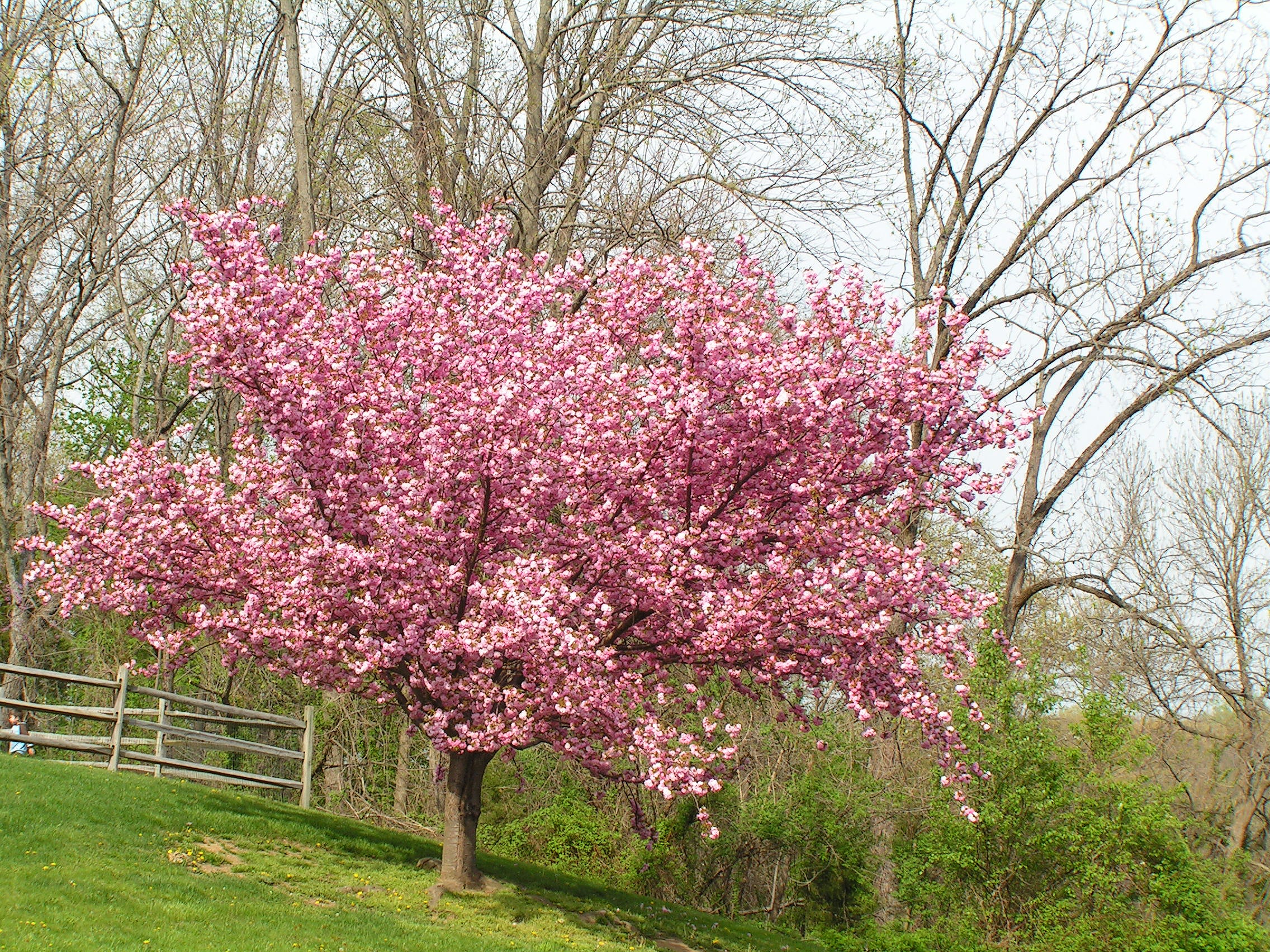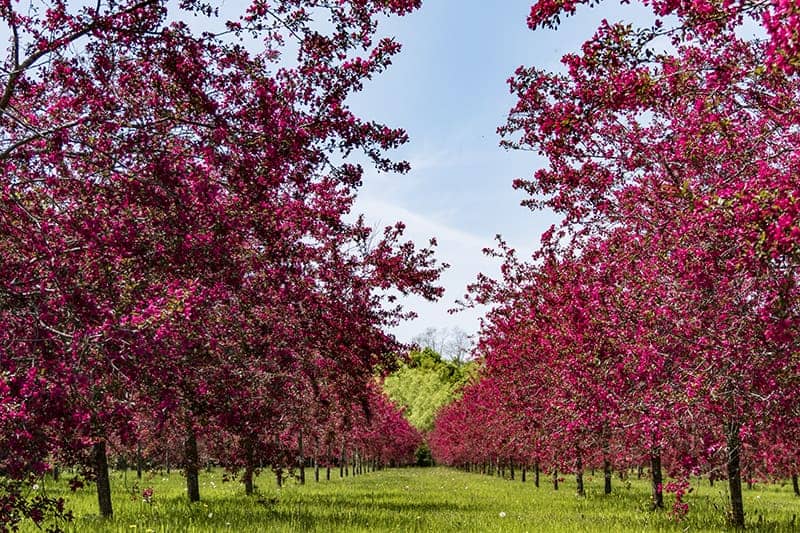- Home >
- Cherry Trees
Cherry Trees for Sale - Buying & Growing Guide
Filters
Price Range
Growing Zones
Plant Type
Flower Color
Sunlight
Mature Height
Plant Characteristics
45 Results
-
Growing Zone(s): 5-8$114.95
$229.95Save up to 50% -
Growing Zone(s): 5-8$199.95
$314.95Save up to 36% -
Growing Zone(s): 5-8$199.95
$239.95Save up to 16% -
Growing Zone(s): 4-8$109.95
$144.95Save up to 24% -
Growing Zone(s): 3-11 / 9-11$99.95
$149.95Save up to 33% -
Growing Zone(s): 5-8$84.95
-
Growing Zone(s): 5-8$119.95
$169.95Save up to 29% -
Growing Zone(s): 3-8$79.95
$159.95Save up to 50% -
Growing Zone(s): 5-10$34.95
$39.95Save up to 12% -
Growing Zone(s): 5-9$134.95
$149.95Save up to 10% -
Growing Zone(s): 4-8$92.95
-
Growing Zone(s): 4-8$114.95
$134.95Save up to 14%
Cherry Trees – Buying & Growing Guide
There are many types of cherry trees – some are mainly grown for ornamental purposes like the famous Yoshino Cherry Trees, while some produce great fruits like the Sweet Cherry Trees. In this guide, you’ll learn about where to buy a cherry tree, how to plant and care for your cherry trees in order to achieve maximum results, and information on the most popular kinds of cherry trees.
How to Grow Cherry Trees
How to plant cherry trees
Plant cherry trees in late winter or early spring, after the ground has thawed but before the trees have budded out. Choose a site away from buildings or anything else that would shade them, and with at least eight hours of sun each day. Cherry trees like a well-drained, rich soil that’s been amended with organic matter. Avoid planting in heavy clay soil, if possible, and shoot for a soil pH of between 6.3 and 7.2.
Properly spacing your cherry trees is important. Standard trees should be at least 30 feet apart; dwarfs, ten feet. Before planting, soak your cherry tree’s roots in a bucket of water for several hours. Dig a hole that’s a little bigger than the root ball after you’ve teased out any circling roots. Place the tree in the hole and spread out the roots. Backfill with a mix of topsoil and manure, compost or peat moss.
If you’re planting a dwarf or semidwarf, make sure the graft union (the bump on the lower trunk) is several inches above grade. Once your tree is planted, shape a low rim of soil around the planting hole so that water has a chance to soak in before it runs off.
Water your plant generously after planting, and mulch with 2-3 inches of organic matter such as shredded leaves. Don’t fertilize newly-planted trees until they’ve had a chance to acclimatize.
How to achieve maximum results
Your cherry trees will have maximum success if they’re sited properly and planted carefully. It’s important to stretch the roots out before planting — if they girdle the tree, they can kill it over time. Regular watering and fertilizing are also important in ensuring that the plant is getting what it needs to produce a bumper crop of cherries.
| Type of Cherry | Mature Height | Spacing | Harvest Season | Sun |
|---|---|---|---|---|
| Bing | 20 feet | 20 to 30 feet | Early July | Full Sun: 6 to 8 hours |
| Lapins | 15 to 20 feet | 15 to 20 feet | July | Full Sun: 6 to 8 hours |
| Rainier | 10 to 15 feet | 10 to 15 feet | N/A | Full Sun: 6 to 8 hours |
| Bada Bing Cherry | 25 feet | 10 to 15 feet | June | Full Sun: 6 to 8 hours |
| North Star Cherry | 10 to 12 feet | 20 feet | Mid-June | Full Sun: 6 to 8 hours |
| Stella | 15 to 20 feet | 20 feet | Mid-June | Full Sun: 6 to 8 hours |
| Black Tartarian | 15 feet | 25 feet | June | Full Sun: 6 to 8 hours |
How to Care for Cherry Trees
Watering and nutrients
Once established, cherry trees don’t need a lot of watering. Give them about one inch every ten days or so. If you’re getting sufficient rainfall, there’s no need for supplemental watering. If you do need to water, a single, deep watering every few days is preferable to light watering every day.
Cherry trees aren’t heavy feeders, and a balanced, low-nitrogen fertilizer designed for fruit trees should be applied once a year in early spring once the tree is mature enough to bear fruit. Before that time, you shouldn’t need to add nutrients if you’ve planted the tree in good soil.
Pollination
Most sweet cherry trees must cross pollinate, so in order to harvest fruit, you’ll need several trees of different cultivars. Sour cherries, on the other hand, are usually self-fruiting.
Honeybees are the primary pollinator for cherry trees, which is why many orchard owners also keep bee hives. If you are unable to do so, you should still be able to reap a good harvest; planting flowers that pollinators like near your trees can help draw bees to your property.
Pruning
Cherry trees need annual pruning to grow robustly and provide a bountiful harvest. Pruning is best done in late winter, before the buds have broken dormancy. Sweet cherry trees are usually pruned to a central leader, which is a main vertical branch with supporting branches circling it. Sour cherries, however, are pruned to a modified central leader, where there is no central branch and the tree is pruned to keep the canopy open.
Whatever form you choose, also prune out dead or deformed branches, as well as any that are rubbing against each other. Make sharp, angled cuts that are about ¼ inch away from an outside bud, using clippers that have been previously sterilized with rubbing alcohol.
Pests, diseases, and animals
Aphids, cherry fruit flies, several varieties of moth species, and borers all prey on cherry trees. In some regions, Japanese beetles are a problem, but they are easily managed with traps. For other insects, there are a range of insecticide products on the market that may be safely used with fruit trees.
Diseases of the cherry include botrytis rot, which can be controlled with a fungicide, buckskin disease, which can be pruned out, and powdery mildew, for which there are organic and conventional treatments such as horticultural spray. Sunscald also impacts trees during hot, dry seasons.
When the trees are in fruit, you may need to net them to keep birds away, as they love to feast on the cherries. Deer won’t usually bother them, and you can avoid trunk damage from small animals by wrapping the trunk in the winter.
Harvesting
Harvesting season for cherries ranges from early June through late July, depending on your variety. You can expect to harvest 8-10 gallons of fruit from a dwarf sweet cherry, while a standard tree that is in good health can produce 15-20 gallons.
Cherries will come off the tree easily when they are ripe; they should be firm and very red. Cherries don’t continue to ripen after they’ve been picked, so you’ll want to taste your tree’s fruit regularly so you can choose the perfect moment to pick.
Types of Cherry Trees – Care Instructions & Pictures
1. Sweet Cherry Tree
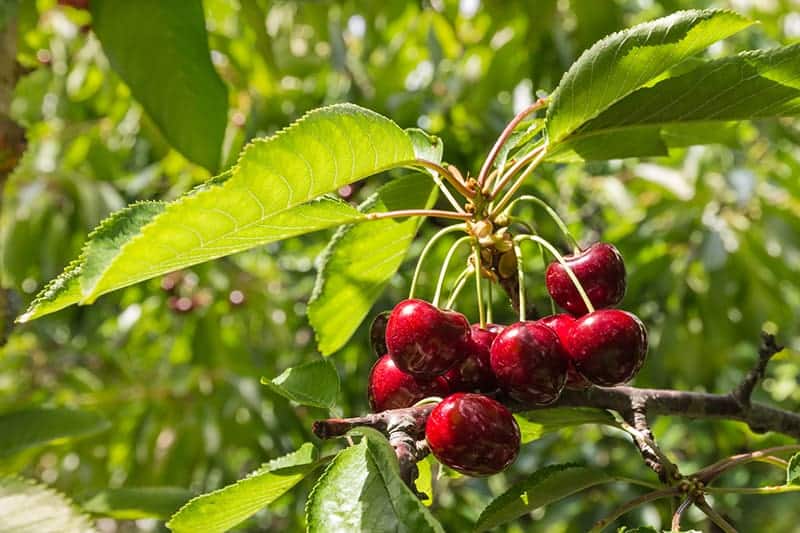
Scientific Name:Prunus avium
Mature Size:Up to 35 feet tall
USDA Hardiness Zone:5-9
Light:Full sun
Water:Maintain moist soil
Soil:Well-draining, fertile
Flower Color:White
Cultivars and Varieties: Prunus avium ‘Stella’, Prunus avium ‘Black Tartarian’, Prunus avium ‘Bing’
These types of cherry trees are those that produce deliciously sweet cherries that are best eaten as fresh fruit, as opposed to cherries that are tart and better utilized in jams and pies. There are several varieties of sweet cherry trees, which can vary in maximum height from 18 to 35 feet. These trees take a natural pyramid form and are usually grown as small to medium trees, or they can be trained to fan out against a wall or fence. These trees are deciduous, with deep green leaves emerging in spring, then developing to bronze and gold in fall. Sweet cherry trees bloom early in spring, with highly fragrant, pretty white flowers. These bloom in small clusters along the branches, before giving way to abundant crops of glossy, sweet cherries. The size and color of the fruit will differ between varieties.
‘Stella’ produces some of the largest fruits, in a deep and dark red color, while ‘Black Tartians’ are a similar color but small in size. ‘Rainier’ produces very large fruits, with an unusual orange-red coloring that makes them look more like cherry tomatoes than cherries. Some varieties, such as ‘Lapins,’ are self-pollinating and, therefore can be planted as single specimens, but others, like ‘Bing’ require cross-pollination and will need to be planted in close proximity to a different variety of sweet cherry tree in order to be able to produce fruits.
These trees perform best in full sun, in a well-draining and fertile soil that is kept consistently moist. Most types of sweet cherry trees require a period of low temperatures over winter to produce buds for flowering. It is recommended that they endure a minimum of 700 hours at temperatures lower than 45 ºF.
2. Tart Cherry
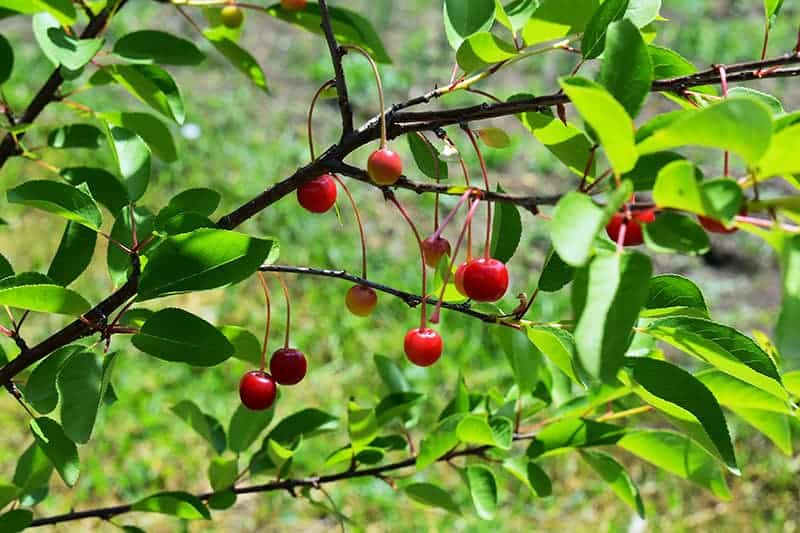
Scientific Name:Prunus cerasus
Mature Size:Up to 20 feet tall
USDA Hardiness Zone:4-9
Light:Full sun
Water:Maintain moist soil
Soil:Well-draining, fertile
Flower Color:White
Cultivars and Varieties: Prunus cerasus ‘North Star’, Prunus cerasus ‘Montmorency’, Prunus cerasus ‘Meteor’
This plant, also known as the sour cherry, is a deciduous medium-sized shrub or small tree. It is native to Europe and Southwest Asia, and produces fruits that are edible, but not commonly eaten in their raw form as they are quite sharp and sour tasting. Instead, these types of cherries are typically used in recipes for preserves, pies, jams, and cakes, or they can be dried and eaten as a snack or turned into a syrup that is used for making liqueurs and other alcoholic drinks. Tart cherry trees take a naturally rounded shape, or alternatively, they can be grown as shrubs and hedging. They produce elliptical leather-like foliage in a deep green color, which develops into a dark orange in the fall before dropping from the tree.
Flowers bloom in clusters along the upright branches in the middle of spring. Flowers are white, and open-faced, with five rounded petals spread out in a star shape. The blooms give way to firm fruits in early to mid-summer. These types of cherries vary in color depending on the variety and cultivar. Morello cherries are darker, whereas amarelle cherries are a brighter and more vibrant shade of red. Inside, their flesh is yellow and acidic. They are less prone to cracking than sweet cherries and are able to hang onto their stems attached to the tree for many weeks.
Though most varieties of tart cherries are self-pollinating, it is recommended that several cherry trees are planted together for improved pollination. They can be planted orchard style, or in rows to create a flowering and fruiting hedge. They are vigorous growers, which are known for producing an abundance of cherries. They can adapt well to a range of soil types providing they are well-draining and kept quite moist, though they prefer fertile soils. Grow them in full sun in climates where temperatures consistently drop below 45º F in the winter.
3. Weeping Cherry Tree
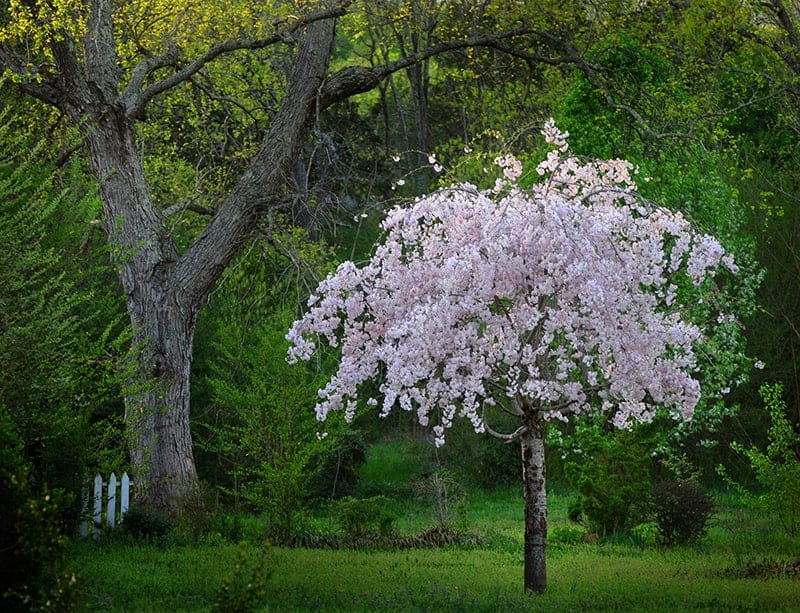
Scientific Name:Prunus pendula
Mature Size:Up to 25 feet tall
USDA Hardiness Zone:5-8
Light:Full sun
Water:Maintain moist soil
Soil:Well-draining, fertile
Flower Color:Pink and white
Cultivars and Varieties: Prunus pendula ‘Pendula Rosea’, Prunus pendula ‘Snow Fountains’
These deciduous trees, as the name implies, have long pendulous branches that droop down to the ground. The shape of the tree will vary slightly between varieties, with some weeping cherry trees having dramatic cascading branches, while others are more arching. These small trees have a very graceful look about them and are particularly stunning in spring when their branches become covered in small, fragrant flowers. These flowers can be soft pink or white, depending on the variety, and can be single or double blooms.
Most weeping cherry trees will flower before the emergence of the foliage, which results in a very striking look. Flowers will last for a few weeks before giving way to small, pea-like, dark fruits. These cherries are not edible, and instead, provide food for birds. As the seasons change, so do the leaves, going from deep green in the summer to yellow and orange in the fall, before dropping from the tree to leave the branches bare in the winter. This ornamental tree is easy to care for and requires little maintenance. It grows in full sun and enjoys moist, well-draining soils.
4. Tibetan Cherry
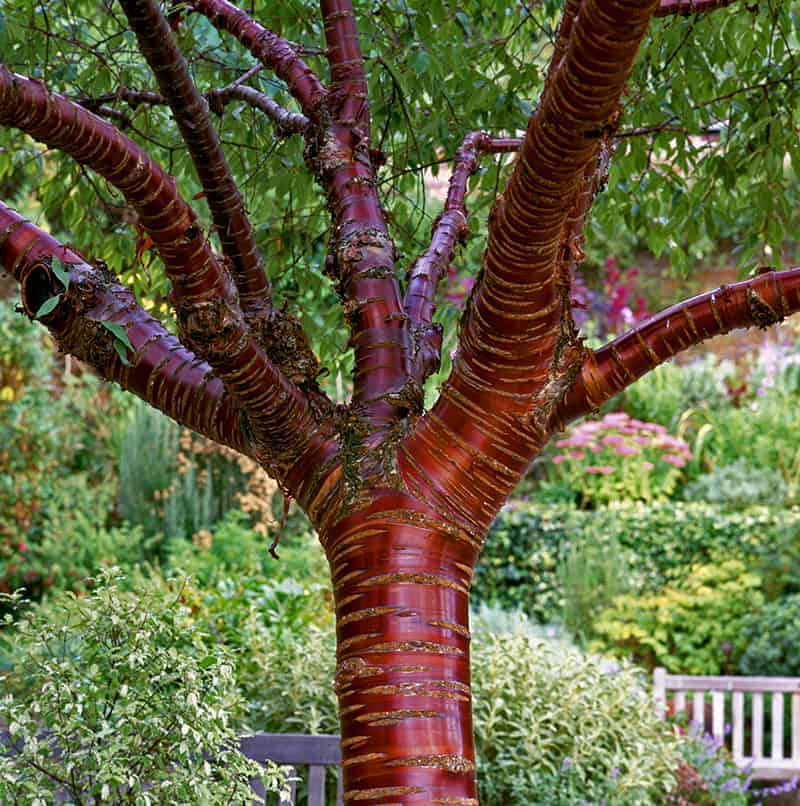
Scientific Name:Prunus serrula
Mature Size:Up to 30 feet tall
USDA Hardiness Zone:6-8
Light:Full sun to partial shade
Water:Maintain moist soil
Soil:Well-draining, organically rich
Flower Color:White
This small, deciduous tree is native to Tibet. It has a naturally rounded habit, and can also be grown as a large shrub. It is noted for its unusual and decorative bark, which has a glossy texture and a rich copper color. It is smooth and shiny, like silk clinging around the trunk of the tree. This stunning bark makes the tree particularly ornamental during winter when the branches are bare and there is little other color in the garden. In spring, the tree produces narrow, deep green leaves, which turn to golden-yellow in the fall before dropping to the ground.
As the foliage emerges, so too do the flowers, appearing in clusters of small, white blooms. These flowers give way to fruits in the fall that take the form of small, red berries. These fruits may be edible, depending on the variety of tree. This is a slow-growing tree that will grow in almost any soil type, though it prefers a moist and well-draining soil with some organic content. It will thrive in both full sun or partial shade.
5. Higan Cherry Tree
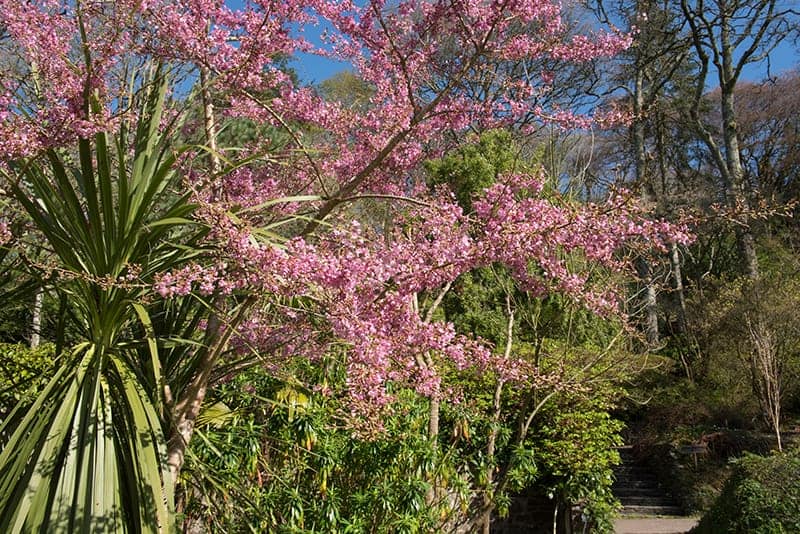
Scientific Name:Prunus x subhirtella
Mature Size:Up to 30 feet tall
USDA Hardiness Zone:6-8
Light:Full sun
Water:Maintain moist soil
Soil:Well-draining
Flower Color:Pink and white
Cultivars and Varieties: Prunus x subhirtella ‘Autumnalis’, Prunus x subhirtella ‘Autumnalis Rosea’
This deciduous tree is very ornamental, thanks to its stunning flowers, long blooming period, color-changing foliage, and interesting overall shape. The tree has an upright, rounded habit, with branches that are rarely bare in spite of its deciduous nature. The tree blooms in late fall, with semi-double flowers that adorn the length of its branches. The buds start out a deep pink or red, and open up to reveal pale pink frilled flowers that gradually fade to white. These flowers remain on the tree from fall all the way through to early spring. By spring, the flowers have developed into pea-sized black berries, which are popular amongst birds and other wildlife.
Foliage emerges in mid to late spring, in shades of deep green. As summer fades to fall, the leaves change from green to brilliant golden-yellow before falling from the tree. This low maintenance tree is more tolerant of hot summers and cold winters than many other types of flowering cherry trees. It thrives in full sun and prefers moist and well-draining soil.
6. Yoshino Cherry Tree
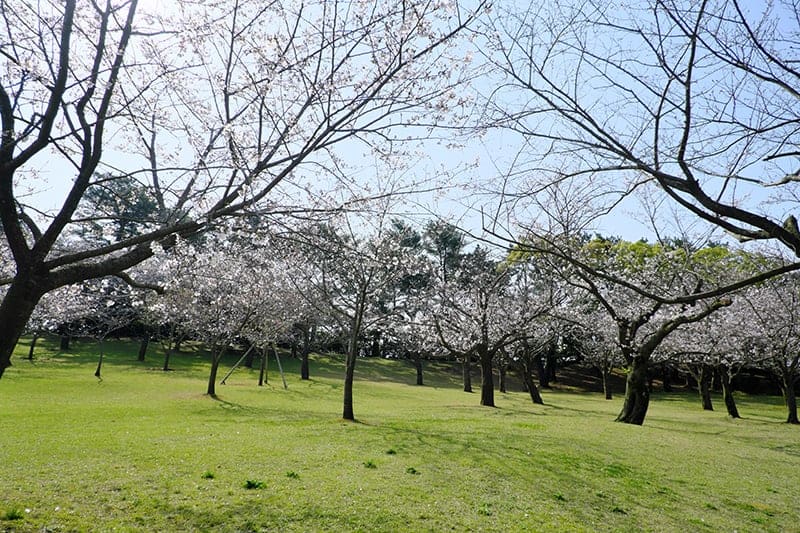
Scientific Name:Prunus × yedoensis
Mature Size:Up to 40 feet tall
USDA Hardiness Zone:5-8
Light:Full sun
Water:Average moisture needs
Soil:Well-draining
Flower Color:Pink and white
Cultivars and Varieties: Prunus × yedoensis ‘Somei-Yoshino’, Prunus × yedoensis ‘Shidare-Yoshino’, Prunus × yedoensis ‘Akebono’
This is a hybrid tree that is a result of crossing two different types of cherry trees. It occurs naturally in Japan, as well as artificially. Depending on the variety of Yoshino cherry tree, the branches of the tree can be upright or have an arching habit. The tree is deciduous, and flowers emerge along the branches before the foliage arrives. Flowers can be white or pale pink, and single, semi-double, or double. They have a mild fragrance that is said to be reminiscent of almonds.
The flowers of this tree bloom in such an abundance that they appear to be completely covering the branches. The flowers give way to small, red berries, which do not have an appealing taste to humans but are very attractive to birds. When leaves emerge, they are glossy and deep green. The foliage fades to yellow and orange in the fall before dropping from the tree.
These trees are enormously popular for their ornamental value and are one of the most widely cultivated types of flowering cherry trees. They thrive in full sun and well-draining, moist soils. However, they are drought-tolerant once mature and can survive purely on rainfall. These trees are able to adapt to a wide range of soil types, even clay or poor soils, as long as drainage is sufficient.
7. Sargent’s Cherry Tree
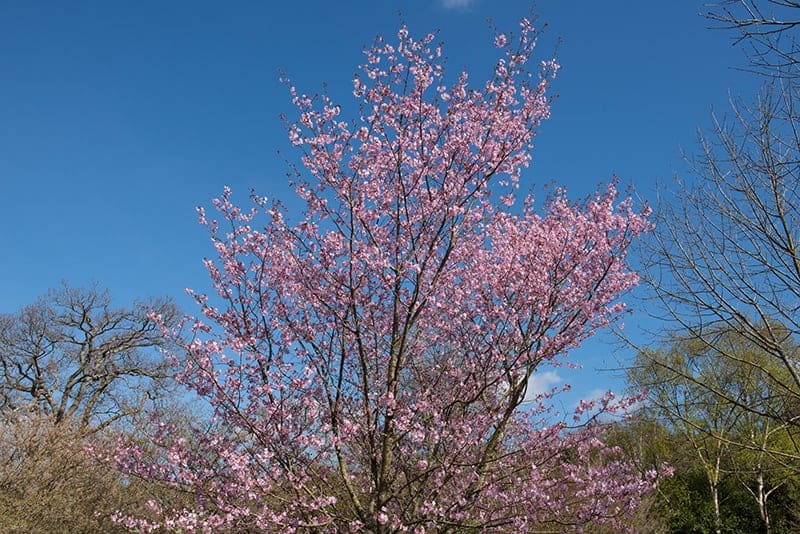
Scientific Name:Prunus sargentii
Mature Size:Up to 30 feet tall
USDA Hardiness Zone:5-9
Light:Full sun
Water:Average water needs
Soil:Well-draining
Flower Color:Pink
This deciduous tree has an upright, rounded habit, which creates an umbrella-shaped canopy once mature. It produces clusters of blooms in spring before the emergence of the foliage, with flowers that vary in color from pale pink to deep, dark pink. The flowers give way to dark purple fruits that are sour to the human palate but are appealing to birds and other wildlife. The ovate leaves arrive in late spring, in a shade of red with serrated edges. As summer arrives, the leaves take on a fresh green hue and a glossy texture. By fall, the foliage becomes orange, red, and yellow before dropping to the ground. In winter, when the branches of the tree are bare, it remains attractive thanks to its ornamental bark, which is shiny and copper-colored.
This tree is a lover of full sun, though it is not heat-tolerant and the leaves may become scorched and damaged in climates that are too intensely hot. It also does not enjoy humidity. Once mature, the tree becomes quite tolerant of drought. It will also tolerate a variety of soil types providing they are able to drain well.
8. Japanese Cherry Tree / Sakura
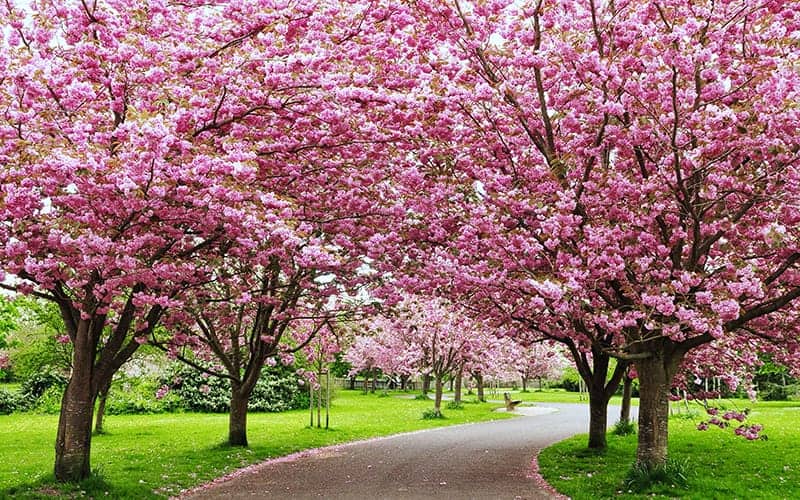
Scientific Name:Prunus serrulata
Mature Size:Up to 30 feet tall
USDA Hardiness Zone:4-9
Light:Full sun to partial shade
Water:Maintain moist soil
Soil:Well-draining, fertile
Flower Color:Pink and white
Cultivars and Varieties: Prunus serrulata ‘Assano’, Prunus serrulata ‘Shogetsu’, Prunus serrulata ‘Kiku-Shidare-Zakura’, Prunus serrulata ‘Pink Perfection’
These trees, also known as flowering cherry trees, are loved for their impressive floral displays. They bloom in various shades of pink and white during spring, with clusters of flowers covering the branches. The foliage is also decorative, emerging in green before changing to bright fall shades of orange, red, and yellow, and then dropping to the ground, revealing attractive bark on the trunk of the tree. These trees thrive in well-draining soil that is kept consistently moist.
